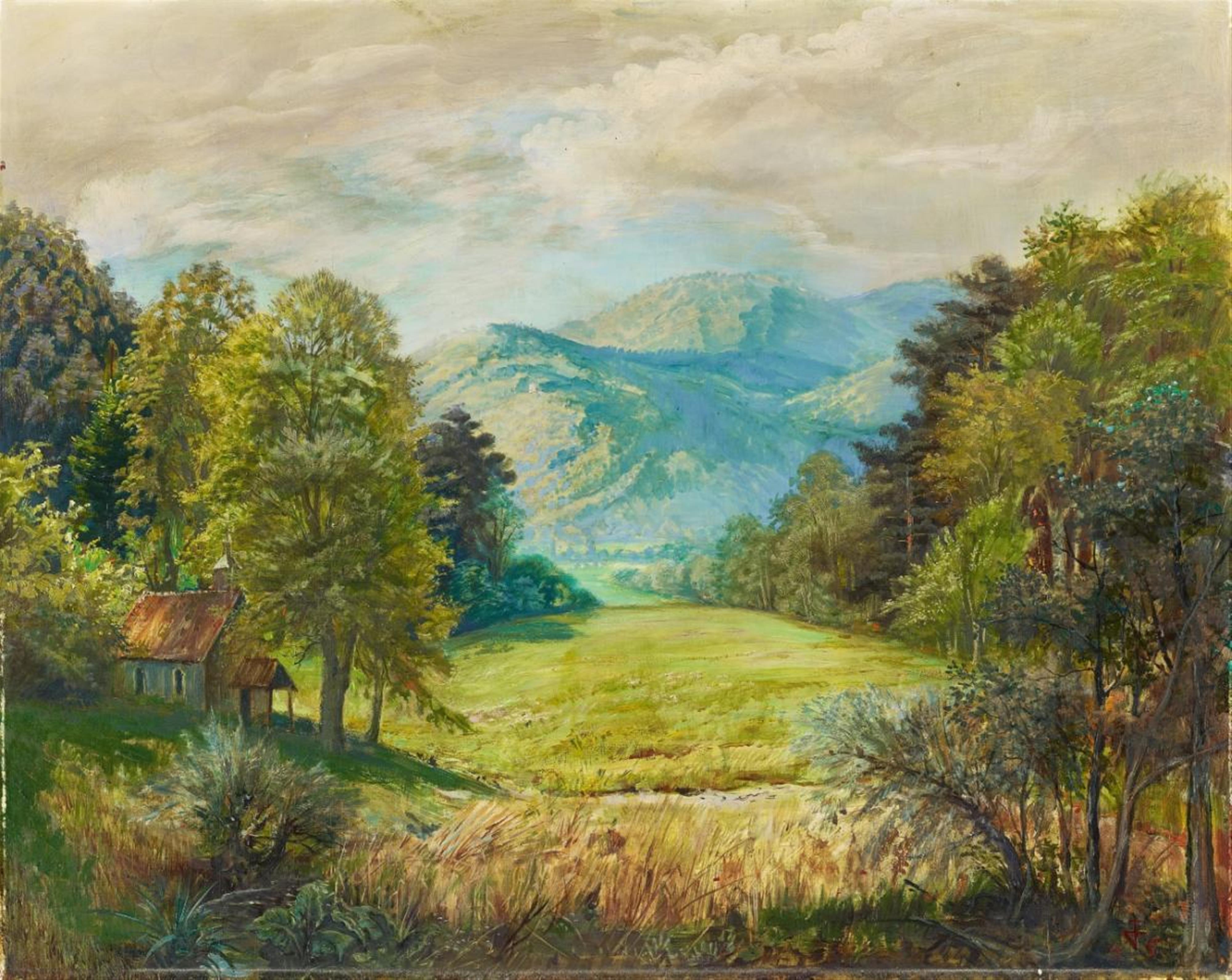Otto Dix
Landschaft bei Zimmerbach mit Bruderkapelle (Munstertal)
1945
Oil and tempera 67.7 x 84.9 cm Dix 45
Oil and tempera on panel 67.7 x 84.9 cm, framed. With the artist's mark and dated '45' in red lower right. - Very fine, original condition.
Not recorded by Löffler
With an expertise by Rainer Beck, Coswig, dated 10 August 2013. The work will be included in the catalogue raisonné of paintings by Otto Dix currently under preparation.
We would like to thank Rainer Pfefferkorn, Otto-Dix-Stiftung, for his kind information. The painting has been registered in the archive under the preliminary no. 1945/24.
Provenance
Gift from the artist to the previous owner (1945); since then in familly possession, France
Literature
See in general: Catherine Teissier (ed.), Otto Dix, Lettres et dessins, Mons 2010
This is a typical work from the period Otto Dix spent as a prisoner of war in Alsace. From April 1945 to February 1946 he was interned at the prisoner of war camp in Logelbach. The Colmar painter Robert Gall, with whom he became friends there, soon furnished the artist with work outside of the camp. Dix thus not only carried out garden work, but also received commissions for paintings from a handful of local families and was able to create these works in Gall's studio. During this period Dix not only painted the romantic Alsatian landscape featuring the Vosges mountains he loved so much (Löffler 1945/6 to 9), but also other works that included portraits (Löffler 1945/4; 1946/9 and 10), an Ecce homo painting (Lempertz, Cologne, Modern Art, Auction 896, 29 Nov 2006, lot 78) and a Head of Christ (Löffler 1946/3) as well as an important triptych containing Mary, Mother of God, and Saints Peter and Paul (Löffler 1945/1a) for the other prisoners of war (cf. Catherine Teissier (ed.), Otto Dix, op. cit., pp. 176 ff., and Löffler, p. 57).
The present work features oil and tempera paint applied in multiple layers over a charcoal underdrawing. Compared to the earlier landscape paintings using a very fine brush and a glazing technique, the present work is more spontaneous, more direct and is aimed more at establishing chromatic relations than a dramatic chiaroscuro contrast. It thus forms a transition to Dix's late-Expressionist late work.
In the left foreground the painting shows the monks' chapel near Zimmerbach in the Munster valley, presumably a reference to Paul Vuillemin (1913-1967). In the background viewers see the Hohneck mountain on the border between Alsace and Lorraine. Because of the dedicated and courageous actions of Vuillemin, a locally well-known priest and member of the resistance, the chapel became a symbol of the resistance's struggle against the Nazi regime. In the Munster valley, a few months before Dix arrived at Logelbach, Vuillemin had been arrested and imprisoned by the Secret Field Gendarmerie. It is safe to assume that Dix knew of the activities and the fate of the priest. In this sense the painting is presumably to be understood not only as a landscape, but also symbolically as a memorial by the moralist Dix.
Catalogue Raisonné
Not recorded by Löffler
Certificate
With an expertise by Rainer Beck, Coswig, dated 10 August 2013. The work will be included in the catalogue raisonné of paintings by Otto Dix currently under preparation.
We would like to thank Rainer Pfefferkorn, Otto-Dix-Stiftung, for kind information. The painting has been registered in the archive under the preliminary no. 1945/24.
Provenance
Gift from the artist to the previous owner (1945); since then in familly possession, France
Literature
See in general: Catherine Teissier (ed.), Otto Dix, Lettres et dessins, Mons 2010

